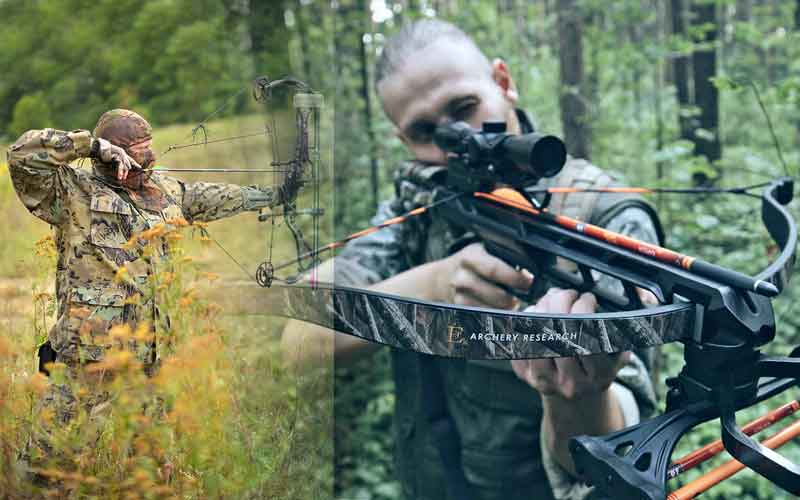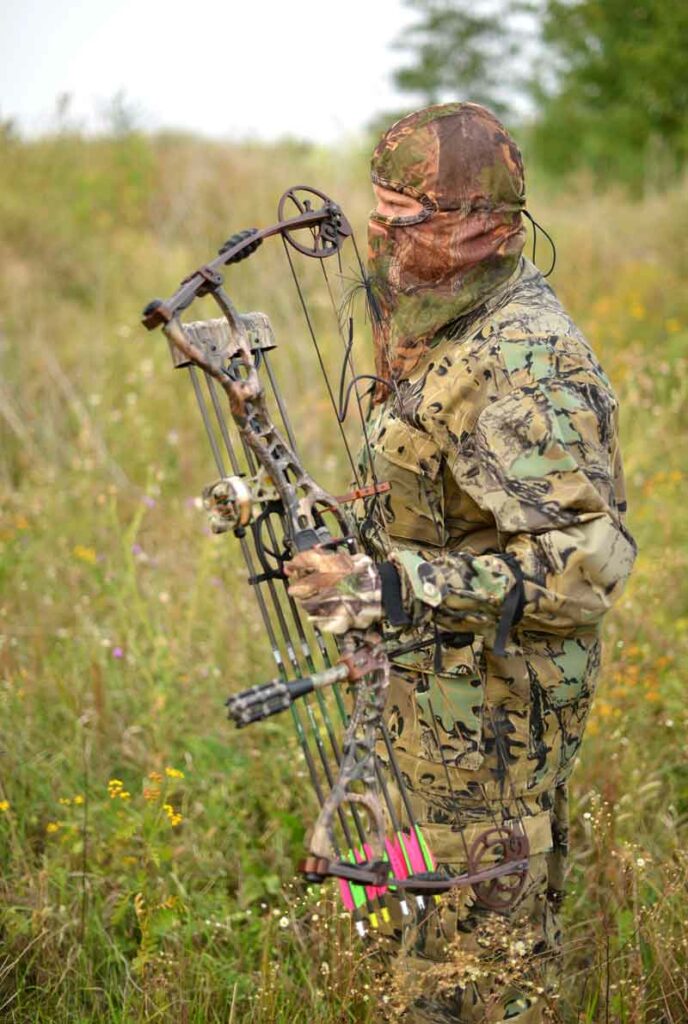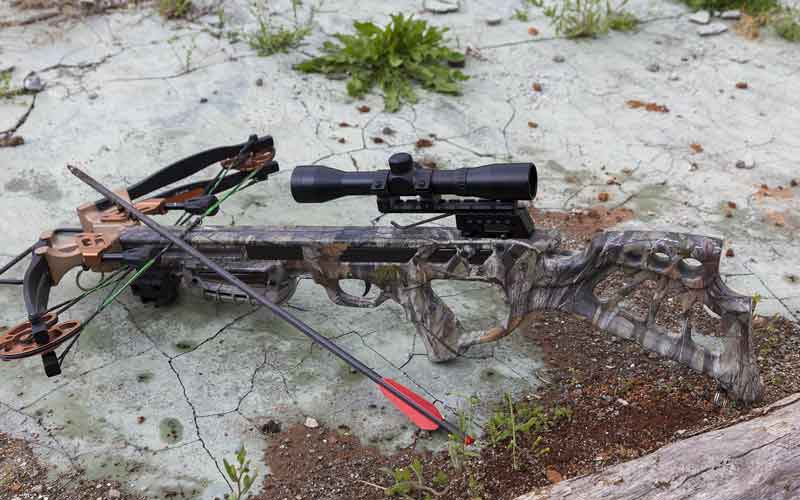
Choosing Crossbows vs Compound Bows – What is the Right Pick?
Understanding the difference between a crossbow and a compound bow can be confusing for anyone new to archery. Both are weapons that use arrows and can deliver a lethal shot, but they function in very different ways.
Crossbows have been used in battle for centuries. Because crossbow manufacturers design their crossbows to be more powerful than modern compound bows, crossbows can generally deliver a robust and more stable shot than a compound bow. They’re far easier to use than a regular bow since the bowstring is already drawn when loaded. They’re perfect for bowhunting because the prey does not have time to flee.
On the other hand, when you consider compound bow advantages, they’re a relatively recent invention. They use a system of pulleys to reduce the draw weight, making them easier to shoot for extended periods. This makes them ideal for target shooting and competition, but they can also be used for hunting. So, if you’re looking to get into archery, the type of bow you choose will depend on your intended purpose.
When it comes to crossbows, there is much debate over which type of bow shoots the crossbow bolt better. While both types of bows have their advantages, at the end of the day it seems that the crossbow may just be a little bit faster and more powerful than its counterpart.
Crossbow Advantages and How They Work

A crossbow is a type of bow that consists of a horizontal bow that is mounted on a stock, making it much easier to aim than a traditional bow. The power stroke of a crossbow is much shorter than that of a vertical bow, which means that it can generate more power with less effort. As a result, crossbows are much more accurate than bows, and they can shoot arrows at speeds of up to 400 feet per second. In addition, the shorter power stroke make them easier to cock, which means that you can shoot more arrows in a shorter period of time.
Whether you’re bowhunting for game or competing in target shooting competitions, mastering the use of a crossbow takes time and practice. Once you’ve got your technique dialed in, there’s no better way to unleash your inner sportsman as you sit in your tree stand, awaiting your success during bowhunting season.
Compound Bows – How They Work
Understanding the difference between a crossbow and compound bows can be confusing for anyone new to archery.

A compound bow is a type of bow that uses a system of pulleys and cables to increase the amount of power that can be generated by the bowstring. This allows it to have a shorter power stroke than a traditional bow while still generating the same amount of power. As a result, compound bows are much more efficient than traditional vertical bows, and they are also easier to aim and hold on target. In addition, the use of pulleys and cables allows the draw weight of a compound bow to be adjusted, making it possible for even beginners to shoot accurately.
Crossbow vs Compound Bow – Size and Weight Difference
Size
One of the most apparent differences is size; a crossbow is much larger and heavier than a compound bow. This can be an advantage or disadvantage, depending on how you plan to use it. A crossbow may be more difficult to transport if you need to carry it long distances or into rugged terrain than a compound bow. However, the extra weight can make the crossbow more stable and easier to shoot accurately.
Weight
There are a few key differences between crossbows and compound bows, one of which is weight. Crossbows tend to be heavier than compound bows due to their additional parts, such as the vertical bow cocking rope. This extra weight can make them more challenging to maneuver, so some hunters prefer the lighter compound bow.
The excess weight of the crossbow can also provide more stability, which may be an advantage when taking long-range shots. If you’re interested in picking up a crossbow or compound bow, check out some of our other articles to find the right one for you.
What Are the Safety Issues Between the Crossbow and the Compound Bow?
There are a few safety issues to consider when choosing between these two weapons. The bow’s weight can be an issue if you hunt, as a heavier bow can be more challenging to control. Additionally, arrow speeds and noise levels can be higher with a crossbow, which could startle prey or attract predators.
Another safety issue to consider is the draw weight of the bow. A higher draw weight means more kinetic energy, which can be dangerous if not appropriately handled.
Finally, crossbows tend to require more maintenance than a compound bow, which could result in additional safety hazards if not maintained properly. It’s essential to weigh these safety issues when deciding which type of bow to use.
Range Comparison
Crossbow
For most crossbows, range is between 20 and 30 yards. Some newer models are designed for longer range shooting, with an effective range of up to 50 yards or more. While shooting beyond this effective range is possible, accuracy will suffer, and the likelihood of hitting the target declines sharply. Therefore, it’s crucial to know your crossbow’s effective range and only take shots that you are confident you can make. You’ll maximize your chances of success and minimize the risk of missing your target.
Compound Bow
The effective range of a compound bow is determined primarily by several critical factors, including the draw weight, draw length, and draw cycle. A compound bow with a draw weight between 30 and 60 pounds will have an effective range of 30 to 40 yards.
Bow Speed
When it comes to speed, the crossbow has a clear advantage. A well-crafted crossbow can fire arrows at speeds up to 400 feet per second, making it one of the fastest bows. In contrast, even the quickest compound bows top out at around 350 feet per second.
This difference in speed can be critical when bowhunting fast moving game or trying to make a long range shot. However, the crossbow’s size and weight can make it more difficult to wield, and its slower rate of fire can be a disadvantage in close quarters combat.
What Is the Accuracy of the Compound Bow vs Crossbow?
There’s no clear cut winner regarding the accuracy, as both types of bows have unique advantages and drawbacks.
Compound bows tend to be better shooters overall, with a high magnification range, fast shooting speeds, and less vibration from each shot.
However, they are also more technical, requiring additional pulleys, cam wheels, and other parts to function correctly.
Crossbows tend to be easier to use and forgiving of any shooting errors; however, they can be slower and less accurate due to their design limitations.
Maintenance Issues
Crossbows and compound bows require different maintenance levels.
Crossbows are typically much easier to care for than compound bows. For one thing, crossbows don’t have as many moving parts as compound bows. This means there are fewer parts that can break or become damaged. Crossbows don’t need to be tuned as often as compound bows. However, crossbows need to be lubricated regularly to prevent the strings from drying out and breaking.
On the other hand, compound bows require more frequent tuning and maintenance to keep them in good working order.
The strings on a compound bow are under a great deal of tension, so they need to be inspected regularly for fraying or damage. In addition, the cables and pulleys on a compound bow need to be kept clean and lubricated to prevent them from binding or breaking. The level of maintenance required for a crossbow or compound bow depends on the individual bow and the amount of use it gets. However, crossbows are generally easier to care for than compound bows, yet still more maintenance than recurve bows.
Bowhunting – What Animals Can You Hunt With Each Weapon?

The two most popular bows for hunters are the crossbow and the compound bow. While each has its own strengths, the ability to hunt a wide variety of animals is arguably the most significant advantage of the crossbow.
Unlike the compound bow, which requires a high degree of physical strength and skill to use effectively, a crossbow can be easily mastered by almost any hunter.
Additionally, a crossbow is more accessible to load than a compound bow and can be fired while remaining safely seated or lying down. This makes it ideal for large game like boar or deer that may need to be shot from afar. Ultimately, while both types of weapons have their place in the hunter’s arsenal, it is clear that the crossbow is unmatched in terms of versatility and ease of use when pursuing big game.
Noise Level Between a Crossbow vs Compound Bow?
When choosing between tools, there are many factors to consider, such as a cost, personal preference, and the type of bow season you plan to hunt. A crucial factor that is often overlooked is the level of noise produced by the bow.
Crossbows are much quieter than compound bows, making them a good choice for hunters who want to avoid spooking games. Modern crossbows typically produce around 85 decibels of noise, while the average compound bow produces approximately 95 decibels.
Of course, there are always exceptions to the rule, and specific models of each type may be louder or quieter than average. Ultimately, it is up to the individual hunter to decide which type of bow is right for them.
What Is the Cost Between a Crossbow and Compound?
There is no clear winner between a crossbow and a compound bow when it comes to cost. Modern crossbows can cost anywhere from $200 to $1,000, depending on the features and quality. On the other hand, the average compound bow costs between $400 and $800. Someone who plans to use their bow for hunting might be willing to pay more for a high-end crossbow designed for precision and power. Conversely, someone who wants to target practice might be pleased with a less expensive compound bow. Seasoned experts might have a preference for cost, but it is simply a matter of finding what works best for beginners.

FAQ
Is It Easier To Use a Crossbow or Compound Bow?
When it comes to deer hunting, both types of weapon have pros and cons. The crossbow is easier to use because it is more like a rifle than a bow. You simply load the crossbow with an arrow and then pull the trigger.
The disadvantages of the crossbow are that it is heavy and bulky, and it takes longer to reload. The compound bow is smaller and lighter than the crossbow, and you can reload it quickly. It’s more challenging to use because you have to hold it at full draw while you aim. In addition, the compound bow has a higher let-off, which means that more energy is transferred to the arrow when you release the string.
As a result, the arrow can travel faster and farther than an arrow shot from a crossbow.
Do You Need a License for a Crossbow?
Recent legislation in many states has made it easier to acquire a hunting license for crossbow hunting. However, there may be certain restrictions or qualifications depending on the specific regulations in your area.
For example, many hunting seasons apply specifically to bow hunting rather than hunting with a crossbow, so you may need to get a hunting license. Additionally, to purchase and use a crossbow from an archery shop or online, you may need to hold a hunting license, which usually requires completing a hunter safety course or passing an examination. Furthermore, ground blinds and elevated stands are often restricted from being used when hunting with a crossbow, although exceptions may apply under certain circumstances.
Given the various regulations and restrictions around acquiring and using these specialized hunting tools, you must understand your local hunting laws before heading into the field with your new crossbow.
Do special forces use crossbows?
Yes, special forces often use crossbows as part of their tactical arsenal. These bows are prized for their lightweight and easy transport, making them ideal for rapid insertion into enemy territory.
Crossbows can be easily cock using their cocking device, limiting the noise and vibration created when firing a shot. Because they are quieter and produce fewer follow up shots than traditional bows, crossbows are also more effective at covert operations.
Overall, special forces find many advantages to using crossbows on the battlefield, making them an essential weapon in any military arsenal.
Is a Crossbow a Good Survival Weapon?
In a word, yes. A crossbow is an excellent survival weapon for several reasons:
Crossbow manufacturers are constantly improving their designs, making crossbows more accurate and easier to use. So if you’re looking for a reliable, high performance survival weapon, a crossbow is definitely worth considering.
- It’s simple to employ, and it doesn’t require much practice to be effective.
- Because it is flexible, it may be utilized for hunting and target shooting.
- It is quiet, so you can use it without disturbing your surroundings.
- It is small and portable, making it easy to carry with you in a survival situation.
- Modern crossbows are powerful and accurate, making them deadly weapons in the right hands.
- In short, a crossbow is an excellent choice for a survival weapon.
So, what sets a crossbow apart from other bows? While the modern crossbow market offers many choices, such as foot pound vertical bows and recurve bows with higher draw weights, the key distinction between a crossbow and other types of bows is the incorporation of a mechanism that propels the arrow when drawn. Unlike other bows, which use only muscle power to propel the arrow forward, crossbows utilize a pulley system or wheels that allow for greater power and range. Additionally, crossbows typically feature much heavier draw weights than other types of bows, making them ideal for hunting large game such as deer or elk. Whether you are an experienced archer or a hunter looking to up your game, it is essential to understand the key differences between a traditional bow and a crossbow. Only by understanding these differences can you make an informed decision about which type of bow is best suited to your needs and goals.
